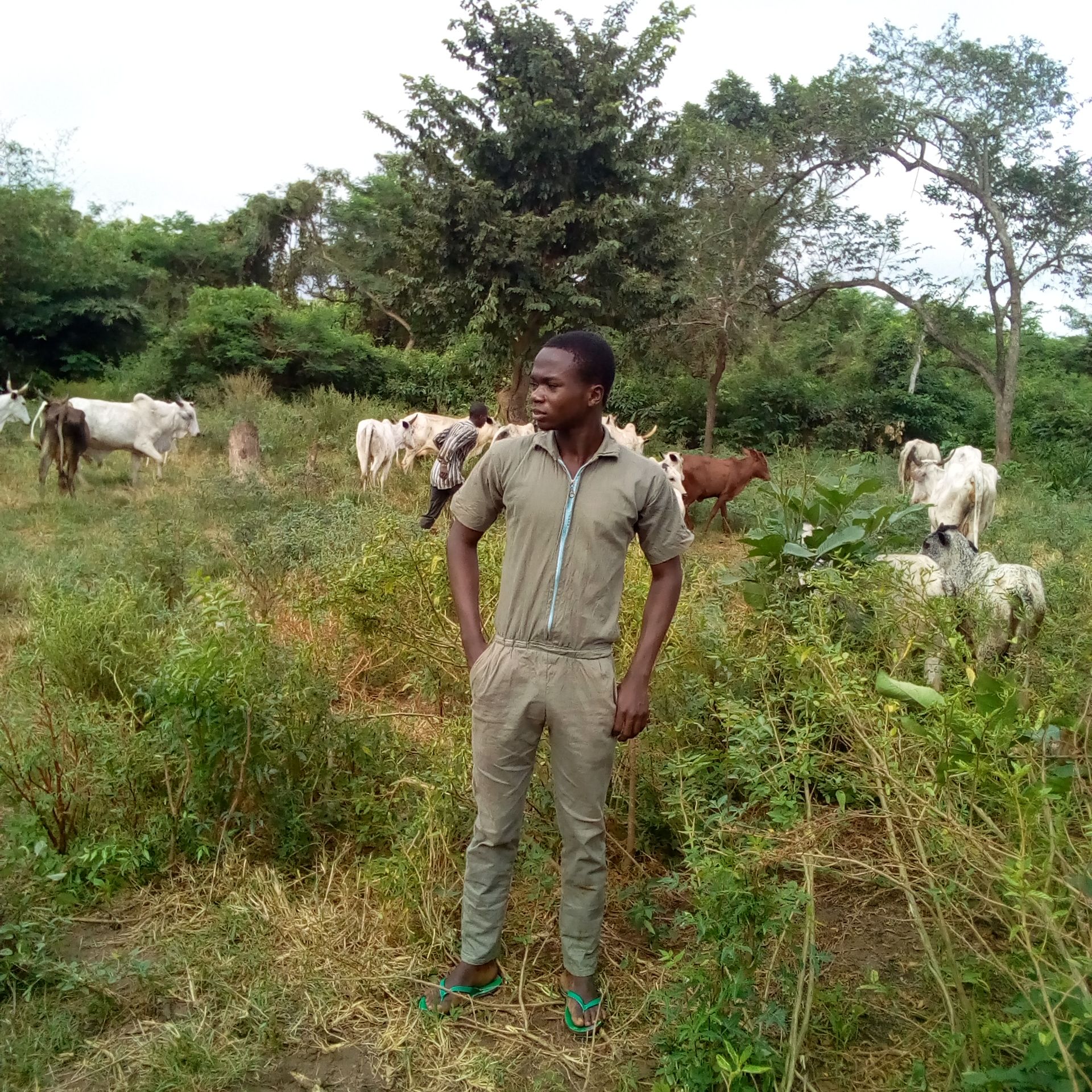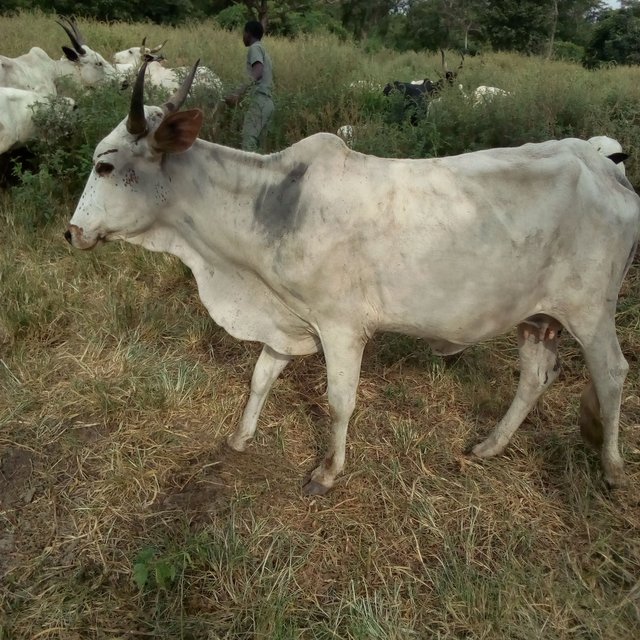Ketosis- a disease that affect cattles and kill fast.
Hello fellow steemian will shedding on ketosis today. And it will be dicussed on headings like epidemiology, pathogenesis, introduction also treatment.
Sit back and enjoy!
Ketosis is a common disease of adult cattle. It typically occurs in dairy cows in early lactation and is most consistently characterized by partial anorexia and depression. Rarely, it occurs in cattle in late gestation, at which time it resembles pregnancy toxemia of ewes (see Pregnancy Toxemia in Ewes and Does). In addition to inappetence, signs of nervous dysfunction, including pica, abnormal licking, incoordination and abnormal gait, bellowing, and aggression are occasionally seen. The condition is worldwide in distribution but is most common where dairy cows are bred and managed for high production.

Picture taken while am on field treating.
Etiology and Pathogenesis
The pathogenesis of bovine ketosis is incompletely understood, but it requires the combination of intense adipose mobilization and a high glucose demand. Both of these conditions are present in early lactation, at which time negative energy balance leads to adipose mobilization, and milk synthesis creates a high glucose demand. Adipose mobilization is accompanied by high blood serum concentrations of nonesterified fatty acids (NEFAs). During periods of intense gluconeogenesis, a large portion of serum NEFAs is directed to ketone body synthesis in the liver. Thus, the clinicopathologic characterization of ketosis includes high serum concentrations of NEFAs and ketone bodies and low concentrations of glucose. In contrast to many other species, cattle with hyperketonemia do not have concurrent acidemia. The serum ketone bodies are acetone, acetoacetate, and β-hydroxybutyrate (BHB).
There is speculation that the pathogenesis of ketosis cases occurring in the immediate postpartum period is slightly different than that of cases occurring closer to the time of peak milk production. Ketosis in the immediate postpartum period is sometimes described as type II ketosis. Such cases of ketosis in very early lactation are usually associated with fatty liver. Both fatty liver and ketosis are probably part of a spectrum of conditions associated with intense fat mobilization in cattle. Ketosis cases occurring closer to peak milk production, which usually occurs at 4–6 week postpartum, may be more closely associated with underfed cattle experiencing a metabolic shortage of gluconeogenic precursors than with excessive fat mobilization. Ketosis at this time is sometimes described as type I ketosis.
The exact pathogenesis of the clinical signs is not known. They do not appear to be associated directly with serum concentrations of either glucose or ketone bodies. There is speculation they may be due to metabolites of the ketone bodies.

Taken with my phone
Epidemiology
All dairy cows in early lactation (first 6 wk) are at risk of ketosis. The overall prevalence in cattle in the first 60 days of lactation is estimated at 7%–14%, but prevalence in individual herds varies substantially and may exceed 14%. The peak prevalence of ketosis occurs in the first 2 wk of lactation. Lactational incidence rates vary dramatically between herds and may approach 100%. Ketosis is seen in all parities (although it appears to be less common in primiparous animals) and does not appear to have a genetic predisposition, other than being associated with dairy breeds. Cows with excessive adipose stores (body condition score ≥3.75 out of 5) at calving are at a greater risk of ketosis than those with lower body condition scores. Lactating cows with subclinical ketosis (Subclinical Ketosis) are also at a greater risk of developing clinical ketosis and displaced abomasum than cows with lower serum BHB concentrations.
Clinical Findings
In cows maintained in confinement stalls, reduced feed intake is usually the first sign of ketosis. If rations are offered in components, cows with ketosis often refuse grain before forage. In group-fed herds, reduced milk production, lethargy, and an “empty” appearing abdomen are usually the signs of ketosis noticed first. On physical examination, cows are afebrile and may be slightly dehydrated. Rumen motility is variable, being hyperactive in some cases and hypoactive in others. In many cases, there are no other physical abnormalities. CNS disturbances are noted in a minority of cases. These include abnormal licking and chewing, with cows sometimes chewing incessantly on pipes and other objects in their surroundings. Incoordination and gait abnormalities occasionally are seen, as are aggression and bellowing. These signs occur in a clear minority of cases, but because the disease is so common, finding animals with these signs is not unusual.
Diagnosis
The clinical diagnosis of ketosis is based on presence of risk factors (early lactation), clinical signs, and ketone bodies in urine or milk. When a diagnosis of ketosis is made, a thorough physical examination should be performed, because ketosis frequently occurs concurrently with other peripartum diseases. Especially common concurrent diseases include displaced abomasum, retained fetal membranes, and metritis. Rabies and other CNS diseases are important differential diagnoses in cases exhibiting neurologic signs.
Cow-side tests for the presence of ketone bodies in urine or milk are critical for diagnosis. Most commercially available test kits are based on the presence of acetoacetate or acetone in milk or urine. Dipstick tests are convenient, but those designed to detect acetoacetate or acetone in urine are not suitable for milk testing. All of these tests are read by observation for a particular color change. Care should be taken to allow the appropriate time for color development as specified by the test manufacturer. Handheld instruments designed to monitor ketone bodies in the blood of human diabetic patients are available. These instruments quantitatively measure the concentration of BHB in blood, urine, or milk and may be used for the clinical diagnosis of ketosis.
In a given animal, urine ketone body concentrations are always higher than milk ketone body concentrations. Trace to mildly positive results for the presence of ketone bodies in urine do not signify clinical ketosis. Without clinical signs, such as partial anorexia, these results indicate subclinical ketosis. Milk tests for acetone and acetoacetate are more specific than urine tests. Positive milk tests for acetoacetate and/or acetone usually indicate clinical ketosis. BHB concentrations in milk may be measured by a dipstick method that is available in some countries, or by the electronic device mentioned above. The BHB concentration in milk is always higher than the acetoacetate or acetone concentration, making the tests based on BHB more sensitive than those based on acetoacetate or acetone.
Treatment
Treatment of ketosis is aimed at reestablishing normoglycemia and reducing serum ketone body concentrations. Bolus IV administration of 500 mL of 50% dextrose solution is a common therapy. This solution is very hyperosmotic and, if administered perivascularly, results in severe tissue swelling and irritation, so care should be taken to ensure that it is given IV. Bolus glucose therapy generally results in rapid recovery, especially in cases occurring near peak lactation (type I ketosis). However, the effect frequently is transient, and relapses are common. Administration of glucocorticoids, including dexamethasone or isoflupredone acetate at 5–20 mg/dose, IM, may result in a more sustained response, relative to glucose alone. Glucose and glucocorticoid therapy may be repeated daily as necessary. Propylene glycol administered orally (250–400 g/dose, [8–14 oz]) once per day acts as a glucose precursor and is effective as ketosis therapy. Indeed, propylene glycol appears to be the most well documented of the various therapies for ketosis. Overdosing propylene glycol leads to CNS depression.
Ketosis cases occurring within the first 1–2 week after calving (type II ketosis) frequently are more refractory to therapy than cases occurring nearer to peak lactation (type I). In these cases, a long-acting insulin preparation given IM at 150–200 IU/day may be beneficial. Insulin suppresses both adipose mobilization and ketogenesis but should be given in combination with glucose or a glucocorticoid to prevent hypoglycemia. Use of insulin in this manner is an extra-label, unapproved use. Other therapies that may be of benefit in refractory ketosis cases are continuous IV glucose infusion and tube feeding.
Prevention and Control
Prevention of ketosis is via nutritional management. Body condition should be managed in late lactation, when cows frequently become too fat. Modifying diets of late lactation cows to increase the energy supply from digestible fiber and reduce the energy supply from starch may aid in partitioning dietary energy toward milk and away from body fattening. The dry period is generally too late to reduce body condition score. Reducing body condition in the dry period, particularly in the late dry period, may even be counterproductive, resulting in excessive adipose mobilization prepartum. A critical area in ketosis prevention is maintaining and promoting feed intake. Cows tend to reduce feed consumption in the last 3 weeke of gestation. Nutritional management should be aimed at minimizing this reduction. Controversy exists regarding the optimal dietary characteristics during this period. It is likely that optimal energy and fiber concentrations in rations for cows in the last 3 wk of gestation vary from farm to farm. Feed intake should be monitored and rations adjusted to meet but not greatly exceed energy requirements throughout the entire dry period. For Holstein cows of typical adult body size, the average daily energy requirement throughout the dry period is between 12 and 15 Mcal expressed as net energy for lactation (NEL). After calving, diets should promote rapid and sustained increases in feed and energy consumption. Early lactation rations should be relatively high in nonfiber carbohydrate concentration but contain enough fiber to maintain rumen health and feed intake. Neutral-detergent fiber concentrations should usually be in the range of 28%–30%, with nonfiber carbohydrate concentrations in the range of 38%–41%. Dietary particle size will influence the optimal proportions of carbohydrate fractions. Some feed additives, including niacin, calcium propionate, sodium propionate, propylene glycol, and rumen-protected choline, may help prevent and manage ketosis. To be effective, these supplements should be fed in the last 2–3 wk of gestation, as well as during the period of ketosis susceptibility. In some countries, monensin sodium is approved for use in preventing subclinical ketosis and its associated diseases. Where approved, it is recommended at the rate of 200–300 mg/head/day.
Authored by @afeezee the vet steemian
References
DYCE veterinary anatomy
LARGE ANIMAL DISEASE
Insight into veterinary pharmacology textbook.
Ruminant medicine disease textbook
Metabolic disease in ruminants
Source: https://www.linkedin.com/pulse/overview-ketosis-cattle-acetonemia-ketonemia-mohammed-essam-sobhy/
Not indicating that the content you copy/paste is not your original work could be seen as plagiarism.
Some tips to share content and add value:
Repeated plagiarized posts are considered spam. Spam is discouraged by the community, and may result in action from the cheetah bot.
Creative Commons: If you are posting content under a Creative Commons license, please attribute and link according to the specific license. If you are posting content under CC0 or Public Domain please consider noting that at the end of your post.
If you are actually the original author, please do reply to let us know!
Thank You!
Hi! I am a robot. I just upvoted you! I found similar content that readers might be interested in:
https://www.merckvetmanual.com/metabolic-disorders/ketosis-in-cattle/overview-of-ketosis-in-cattle
Hello @afeezee, you got the cheetah comment because your post contains plagiarized content which is against the rules of steemit and the #steemstem community. Please read the guidlines for creating STEM content here and information about copyright here. You can also read this post for an overview of how to create quality STEM content.

Finally, if you haven't, please join the steemstem community on discord to learn more.
Thanks for helping out.
Is there a remedy then?
Like for me to engage and make better steemstem post?
Or because cheetah commented this account has been blacklisted on steemstem. And no other post from it can be considered?
You are not blacklisted. Please do not copy and paste other people's work. Thank you.
Resteemed your article. This article was resteemed because you are part of the New Steemians project. You can learn more about it here: https://steemit.com/introduceyourself/@gaman/new-steemians-project-launch